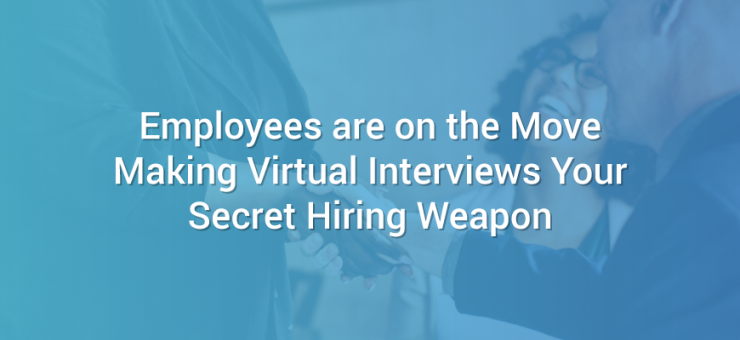For years, there’s been talk about a talent shortage. Today, the hiring world is focused on how low-unemployment is only increasing the talent crisis. In fact, new data from the 2018 Deloitte Millennial Survey shows proof that hiring pros need to adjust their focus to what may be a mass career exodus. The results revealed 43 percent of millennials plan on exiting their jobs within the next two years.
Additionally, The Labor Department recently reported the percentage of workers across all age groups quitting their jobs reached 2.4 percent in May, the highest level in 16 years. While no company leader wants to hear this seemingly ominous news, it could be the break hiring professionals need.
But to make the most of this anticipated increase in employee exits, hiring professionals need to ensure they’re fully equipped and prepared to use virtual interviews to impress new talent. To do this, they must first understand why employees are preparing to quit as well as how virtual interviews can address those issues.
Let’s take a look at how you can use virtual interviews to attract talent as they begin exiting their current careers:
Offer flexibility as a necessity, not a perk
The New York Post recently profiled 25-year-old Sarah Soloman who quit her high-powered, glamorous NYC PR firm job to chase her dreams to travel around the world. Like Soloman, many millennials resent the lack of flexibility offered by the majority of companies and are taking control of their lives by leaving even the most high-paying jobs to find it.
Respondents in the previously mentioned Deloitte report are on the same page. Fifty percent of millennials in the report say flexible hours and location are “very important” when choosing to work for an organization. An additional 44 percent of Gen Z employees say the same.
Younger employees are feeling burnt out, making flexibility in all organizational aspects a necessity, not a perk. Virtual interviews give them the power to choose when and where they want to interview.
Some potential candidates may be off taking a much-needed mental break, while others would need to schedule around a strict work schedule. No matter what their status, virtual interviews have the ability to make them feel valued and less anxious during the hiring process — something they’re craving when feeling overwhelmed and tied down.
Prove you’re not stuck in the mud
Employees believe forward-thinking companies are making a difference in the world. Respondents in the Deloitte report who say business leaders are making a positive impact on the world also say their employers are making ‘great’ use of Industry 4.0.
They go on to suggest employers offering increased flexibility achieve greater profitability and provide work environments that are stimulating, healthy, and satisfying.
The importance of Industry 4.0 to employees revolves around the idea that employers are focused on the future. As AI and other advancing technologies drastically change the business world, candidates want to know the next career move they make is with a company that’s prepared for the future.
While virtual interviews still rely on human-based decisions, unlike Industry 4.0 technology, they show your company leaders are adaptive and unafraid of moving into the future. Offer one-way virtual interviews as a sign that you’re both flexible and prepared to take on futuristic technology. Before candidates begin the interview, present fun video testimonials of your current employees to immediately establish a connection to your healthy and stimulating work environment.
Show your priorities
Many employees, especially millennials, are losing faith in business. The majority of millennials in Deloitte’s report, for example, believe companies have no ambition beyond making money. During the interview process, hiring professionals must prove their priorities go far beyond monetary gains if they’re going to sway candidates in their direction.
Today’s candidates need to know you’re concerned with their experiences and positively impact your current employees’ lives with nontraditional working conditions. To do this, allow candidates to schedule their own virtual interviews using an online scheduler. By simply clicking on a link and choosing a time that works for them, candidates will feel empowered by your process.
This first impression will set the tone for the rest of the interview process, showing candidates their time is important to you. Then, during virtual interviews, bring in their potential future co-workers to answer any questions about tasks, culture, and even company priorities.
—
How do you use virtual interviews to bring candidates to your team? Let us know!











